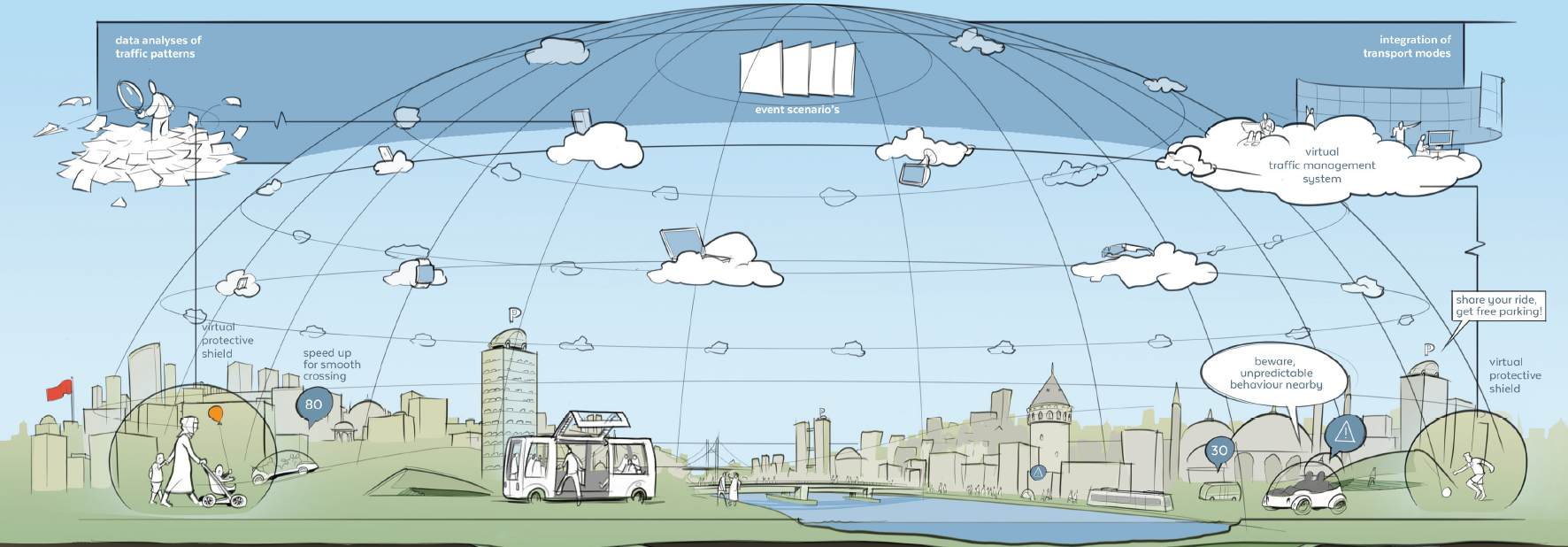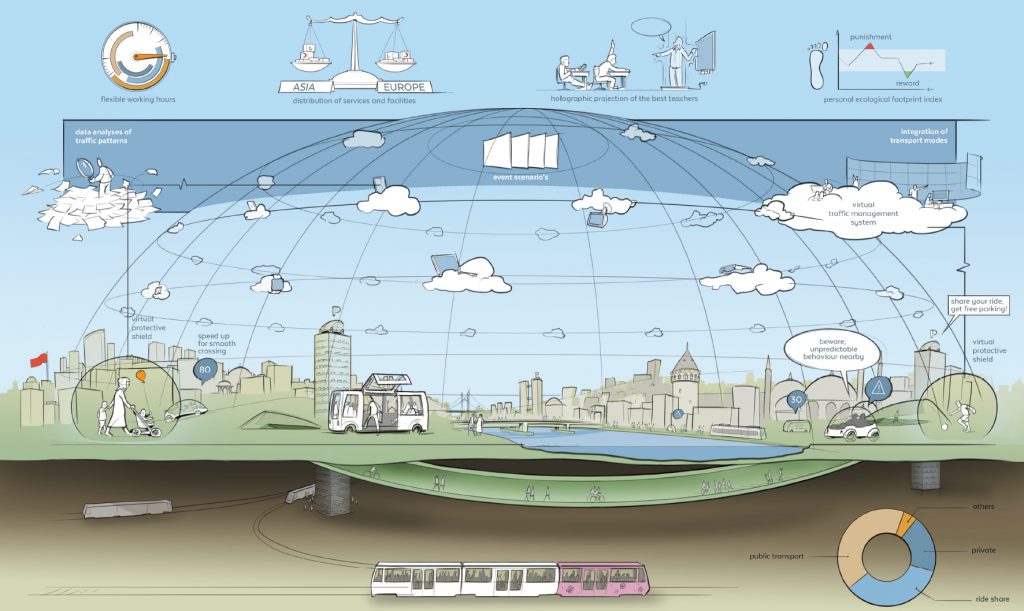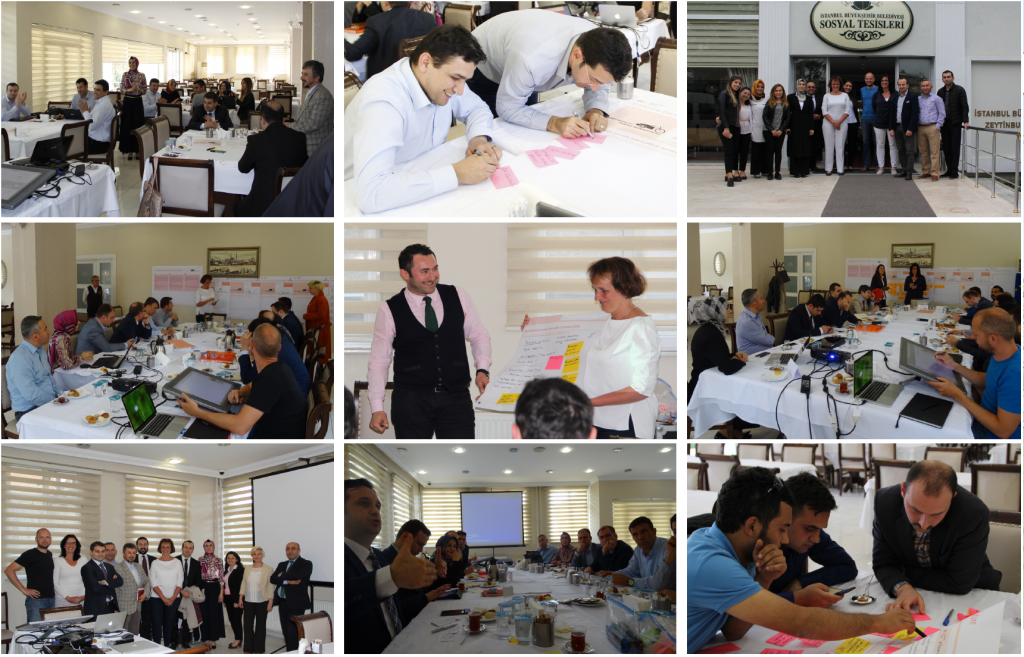Istanbul Vision Development 2050

Vision development for Istanbul 2050
The R4E project has completed the “Vision development” stage, which consisted of designing the services and characteristics that our cities should offer in the year 2050, based on the opinions and contributions of municipal experts of each city, their stakeholders, politicians and municipal managers. To better illustrate the process, images have been created that reflect the way our cities could look in 2050, including the services and characteristics agreed upon in the workshops for each of the project’s focus areas.
MOBILITYPERSONALISED, SMOOTH, SAFE TRAFFIC IN ISTANBUL 2050
In 2050, individual travellers in Istanbul are valued and facilitated by personalised travel advice. Smart technologies and apps enable personalised route planning. Communication between vehicles, drivers and infrastructure allows smart signalling. Green behaviour is encouraged by a range of personalised, sustainable options.
People value fast, smoothly flowing traffic, free from congestion. Automated systems support smooth traffic flows through the city. Mass transport solutions are attractive thanks to flexible charging and working hours. Alternative routes and transport modes are conveniently available. People value better air quality and choose healthier options such as walking and cycling. Traffic is safe. Smart safety measures help to avoid accidents and traffic violations. Vehicles are equipped with smart solutions and options to communicate, both with other road users and with the infrastructure.
What characterises the city of Istanbul in the focus area of Smart Mobility and the elements of the desired future scenarios are:
1. Smart traffic management system
All traffic in Istanbul is managed through a single, safe, reliable and efficient system. The system connects all public and private vehicles, devices and road users and is accessible from anywhere. Data is collected to analyse the traffic movements and provide real-time (event-driven) smart traffic management.
2. Compact smart e-vehicles:
People make use of personalised services based on compact smart vehicles. Vehicles are sustainable (using recycled materials and with zero-emissions) and are charged at widely available charging stations using renewable energy sources. The service allows easy reservation, flexible payment and pick-up/drop-off at any point. Personal profiles (e.g. including a network of friends) and connection to the smart system provide routes and options to share rides with friends.
3. Strategic demand management
People travel less because high-quality services are available remotely. Remote health monitoring and preventive health services reduce the need to visit distant hospitals. High-quality training and education are available in all districts, for example through holograms of excellent teachers. Flexible school and working hours and relocation of offices spread the demand for travel. Ride-sharing and air-cargo drones reduce road traffic. Ride-sharing is safe and efficient thanks to easy reservation and accessibility (e.g. special, cheaper parking for shared cars).
4. Sustainable, healthy behaviour
Citizens have adopted healthy lifestyles. Activity levels are measured by wearable devices, and more walking is rewarded by privileged services. The use of private cars has been reduced. The new generation of people care about sustainability and use the system to make optimal choices (balancing costs, emissions, time, social aspects etc.).
FULLY INTEGRATED, ACCESSIBLE & SUSTAINABLE MOBILITY IN ISTANBUL 2050
In 2050, a clean, green and healthy environment is valued by the citizens of Istanbul. Travellers appreciate the wide range of alternative routes and forms of transport. Public transport benefits everyone by providing good accessibility to all modes of transport. These are seamlessly integrated, providing a closely-knit network that reaches every part of the city while respecting its historical heritage.
Travellers choose sustainable and healthy options. Public transport provides a single route to people’s destinations, without disruptions caused by changes between modes. Travellers value the availability of accurate, up-to-date and cross-modal information. This enables them to choose the best options as and when they need them, taking into account changing situations and transport availability. And the public transport systems use renewable energy resources.
1. A clean and green city
In 2050, Istanbul is a clean and green city. A whole new city concept has been created around emission-free and ecological buildings with green roofs and waste recycling. In green areas all over the city residents enjoy walking, cycling and (hobby and urban) gardening. Pedestrian tunnels and floating gardens connect the areas. Citizens are energy-aware; a tree is planted for each child’s birthday. Energy efficiency and sustainability are monitored for continuous improvement.
2. Seamless transport and pleasurable travel experience
Istanbul has an integrated transport system that provides door-to-door service. Buses, trams, automated vehicles, taxis, shared cars and bikes are all integrated into one, easily accessible service. New modes of transport and innovative vehicles are also integrated, like autonomous vehicles in the air and on water. The integration of smaller units (personal or larger) into larger ones (ferries or trains) avoids transfers. Management is by an autonomous system.
‘Public’ transport provides a pleasurable and comfortable travel experience. The PRT (personal rapid transit) system allows people to travel in their own units, which are transformed into DRTs (demand response transit) with VIP services. People can easily transfer between all vehicles at hubs. These are real experience centres, with shopping, cinemas, and theatres.
3. Personal travel assistant
Everyone has a virtual ‘guardian angel’ for personal travel advice wherever they are, free of charge. All the ‘angels’ are connected to the cloud for accurate, up-to-date, cross- modal information. They give warnings of storms or snowfall, help to cancel or postpone trips when needed, help in case of emergencies or prevent accidents by warnings. They balance capacity in the system, important city parameters (energy, air quality, etc.) and personal health parameters.
4. Privacy & security
People feel comfortable and safe, because only the ‘angels’ have access to personal data. In 2050, the transport systems in Istanbul are also perceived as secure. For example, the biometric information used to identify people at entry points is also used to identify suspicious persons and activities. Personal data banks have a virtual shield to ensure confidentiality and privacy, and guard against hacking.
All these ideas and input have emerged from the participatory workshops that have taken place in the city of Istanbul and whose images can be seen below:



Leave a Comment